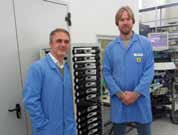Changing Course

Taking A Hard Look At What’s Next For Green AV Across Our Industry
by Scott Walker
Over the course of my time writing for Systems Contractor News, I have focused heavily on the LEED sustainability rating process and recommended that the AV industry should seek to overwhelm USGBC with attempted innovation credits based on AV solutions. However, a funny thing happened while writing the September article on innovation credits: by the time I finished writing it, I had convinced myself that we were, quite probably, on a road to nowhere.
It Seemed Like Such A Good Idea At The Time
USGBC had created a fantastically popular rating system for green buildings, so seeking a home for sustainable AV solutions within LEED seemed like the obvious first place to go, but the obstacles were great. The first obstacle was just getting a seat at the table. A project’s potential innovation credits are typically identified at the LEED charrette, which usually takes place early in program phase or schematic design phase. A handful of consultants might find themselves at that table, but this is not a place where most AV manufacturers, integrators, and software programmers have a home, and there aren’t enough consultants to make much of a difference over the next few years.
The second and more profound obstacle became apparent when I was doing my very unscientific research for Systems Contractor News’ September column. I tried to measure how much impact we could have on the LEED rating system if we launched a full-on assault of innovation credits, and I found that the results would be negligible. Most commercial LEED projects are new construction; new construction takes years to complete and even longer to actually earn their LEED certification, and I estimate fewer than a dozen or so actual proposed AV innovation credits on real projects are under consideration at this time. So, if we green AV advocates go nuts starting now and begin in earnest proposing AV innovation credits on every project we can, we might successfully earn 100 or so actual credits on real projects by the end of 2012. And that’s being optimistic.
Currently, nearly 30,000 commercial projects are in the pipeline for LEED consideration, and nearly all of them will earn their requisite four or five innovation credits. Thus, by 2012, if we in the AV industry earn 100 of the roughly 120,000 innovation credits on these 30,000 projects, our credits represent 0.083 percent of just the innovation credits earned. We’re not going to get anyone’s attention when we’re not even one-tenth of one percent of the innovation credits, which themselves are only five percent of the total credits within LEED.
A daily selection of the top stories for AV integrators, resellers and consultants. Sign up below.
Enter Plan B
In 2009 the InfoComm Board of Directors authorized the creation of a Green AV Task Force. Our mandate was to create a body of green AV knowledge and associated best practices. While we did many good things on the task force last year, we essentially missed the mark of our stated mandate because there was/is no generally accepted definition of what a green AV system is nor is there a good way to measure or compare a purported “green AV” installation against a standard “non-green AV” system.
Last fall the Green AV Task Force met and decided to change course, deemphasize our pursuit of LEED, and create our own AV sustainability rating system. We presented our idea to the InfoComm Board in December, and in February they approved this new initiative and the AV Sustainability Task Force was formed to guide the initiative. The task force is made up of representatives from AV manufacturing, integration, consulting, software programming, as well as an end user / technology manager representative, since this initiative ultimately will benefit the buyers of our solutions while it seeks to raise the value proposition of those who can deliver sustainable solutions.
Our framework seeks to learn from LEED but not copy it. Our system invites participation throughout the project from AV program phase through occupancy from the entire AV ecosystem. Now, AV manufacturers will have a place where their green products, shipping practices, and facilities can count for something. Consultants, integrators, and software programmers will collaborate to share responsibility in the planning, design, integration, and programming of systems to minimize energy consumption while still promoting AV quality. And finally the buyers of AV goods and services will have a clear way to specify their sustainability goals and measure the ROI of their sustainable AV investments.
The current draft framework of the rating system will be unveiled for input and feedback from the AV community at a free session Friday, June 11, from 10:30 a.m. to noon at InfoComm 2010 in Las Vegas, NV. The session will take place at Las Vegas Convention Center in room N-252. Come share your ideas with us. We want the energy and vision of the entire industry fueling this initiative.
The era of talking about green AV is over. We’re in the action phase now
Scott Walker, CTS-D, LEED AP, is president of Waveguide Consulting and past president of InfoComm International. In June 2007 he made history when he became the world’s first LEED-accredited certified technology specialist in design.
Green ScenePowersoft Manufactures Green

Powersoft managing director Claudio Lastrucci (left) with visitor Kurt Springer, director of touring for MSI, at the Powersoft manufacturing plant.
FARMINGDALE, NY—Powersoft has formed a manufacturing partnership with the MetaSystem Group, a group of Italian companies that operate in the electronics field with a specific focus on the automotive, telematics, energy, photovoltaic, telecommunications, and broadcasting sectors. The MetaSystem plants feature solar cell production of electricity as a cornerstone of green manufacturing practices and have advanced automatic assembly, visual inspection systems, and cutting-edge, in-circuit testing equipment for efficient production.
Leviton Reduces Energy Use
MELVILLE, NY—Leviton Manufacturing Company has collaborated with Long Island Power Authority (LIPA) to build in long-term sustainability initiatives at its Melville world headquarters. On Earth Day, LIPA executives visited Leviton’s facility to present a rebate check as part of the utility’s Commercial Efficiency Program, which offers businesses discounted energy rates and rebates for installing energy-efficient devices and systems. Many of the installed systems at the complex include daylight harvesting, commercial sensors, and lighting energy management systems.
New Casio Site
DOVER, NJ—Casio America has launched its “Green Slim Projector” website, providing consumers with new details about the company’s recently announced line of mercury free, high brightness projectors. The site will also be a resource for up-to-the-minute industry news.
